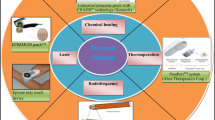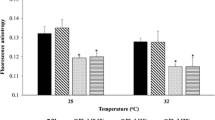ABSTRACT
Purpose
To investigate mechanism of microwave enhancing drug permeation transdermally through its action on skin.
Methods
Hydrophilic pectin-sulphanilamide films, with or without oleic acid (OA), were subjected to drug release and skin permeation studies. The skins were untreated or microwave-treated, and characterized by infrared spectroscopy, Raman spectroscopy, thermal, electron microscopy and histology techniques.
Results
Skin treatment by microwave at 2450 MHz for 5 min promoted drug permeation from OA-free film without incurring skin damage. Skin treatment by microwave followed by film loaded with drug and OA resulted in permeation of all drug molecules that were released from film. Microwave exerted spacing of lipid architecture of stratum corneum into structureless domains which was unattainable by OA. It allowed OA to permeate stratum corneum and accumulate in dermis at a greater ease, and synergistically inducing lipid/keratin fluidization at hydrophobic C-H and hydrophilic O-H, N-H, C-O, C=O, C-N regimes of skin, and promoting drug permeation.
Conclusion
The microwave technology is evidently feasible for use in promotion of drug permeation across the skin barrier. It represents a new approach in transdermal drug delivery.










Similar content being viewed by others
REFERENCES
Wong TW. Use of microwave in processing of drug delivery systems. Curr Drug Deliv. 2008;5:77–84.
Nakamura H, Matsuzaki I, Hatta K, Nobukuni Y, Kambayashi Y, Ogino K. Nonthermal effects of mobile-phone frequency microwaves on uteroplacental functions in pregnant rats. Reprod Toxicol. 2003;17:321–6.
Colombo R, Lev A, Da Pozzo LF, Freschi M, Gallus G, Rigatti P. A new approach using local combined microwave hyperthermia and chemotherapy in superficial transitional bladder carcinoma treatment. J Urol. 1995;153:959–63.
Van der Heijden AG, Kiemeney LA, Gofrit ON, Nativ O, Sidi A, Leib Z, Colombo R, Naspro R, Pavone M, Baniel J, Hasner F, Witjes JA. Preliminary European results of local microwave hyperthermia and chemotherapy treatment in intermediate or high risk superficial transitional cell carcinoma of the bladder. Eur Urol. 2004;46:65–72.
Anscher MS, Lee C, Hurwitz H, Tyler D, Prosnitz LR, Jowell P, Rosner G, Samulski T, Dewhirst MW. A pilot study of preoperative continuous infusion of 5-fluorouracil, external microwave hyperthermia, and external beam radiotherapy for treatment of locally advanced, unresectable, or recurrent rectal cancer. Int J Radiat Oncol Biol Phys. 2000;47:719–24.
Djavan B, Larson TR, Blute ML, Marberger M. Transurethral microwave thermotherapy: what role should it play versus medical management in the treatment of benign prostatic hyperplasia. Urol. 1998;52:935–47.
Giombini A, Giovannini V, Di Cesare A, Pacetti P, Ichinoseki-Sekine N, Shiraishi M, Naito H, Maffulli N. Hyperthermia induced by microwave diathermy in the management of muscle and tendon injuries. Br Med Bull. 2007;83:379–96.
Korpan NN, Saradeth T. Clinical effects of continuous microwave for postoperative septic wound treatment: a double-blind controlled trial. Am J Surg. 1995;170:271–6.
Nor Khaizan A, Wong TW, Mohd Nasir T. Microwave modified non-crosslinked pectin films with modulated drug release. Pharm Dev Tech. 2012;17:110–7.
Meyer DE, Shin BC, Kong GA, Dewhirst MW, Chilkoti A. Drug targeting using thermally responsive polymers and local hyperthermia. J Control Release. 2001;74:213–24.
Moriyama E, Salcman M, Broadwell RD. Blood–brain barrier alteration after microwave-induced hyperthermia is purely a thermal effect: I: temperature and power measurements. Surg Neurol. 1991;35:1771–82.
Fadilah R, Pinkas J, Weinberger A, Lev A. Heating rabbit joint by microwave applicator. Arch Phys Med Rehabil. 1987;68:710–2.
Yang WJ, Wang JH. Shortwave and microwave diathermy for deep-tissue heating. Med Biol Eng Comput. 1979;17:518–24.
Ruddy SB, Hadzija BW. The role of stratum corneum in electrically facilitated transdermal drug delivery. I. Influence of hydration, tape-stripping and delipidization on the DC electrical properties of skin. J Control Release. 1995;37:225–38.
Gill HS, Andrews SN, Sakthivel SK, Fedanov A, Williams IR, Garber DA, Priddy FH, Yellin S, Feinberg MB, Staprans SI, Prausnitz MR. Selective removal of stratum corneum by microdermabrasion to increase skin permeability. Eur J Pharm Sci. 2009;38:95–103.
Babu RJ, Pandit JK. Effect of penetration enhancers on the release and skin permeation of bupranolol from reservoir-type transdermal delivery systems. Int J Pharm. 2005;288:325–34.
Lee PJ, Ahmad N, Langer R, Mitragotri S, Shastri VP. Evaluation of chemical enhancers in the transdermal delivery of lidocaine. Int J Pharm. 2006;308:33–9.
Lavon I, Kost J. Ultrasound and transdermal drug delivery. Drug Discov Today. 2004;9:670–6.
Naik A, Kalia YN, Guy RH. Transdermal drug delivery: overcoming the skin’s barrier function. Pharm Sci Tech Today. 2000;3:318–26.
Merino G, Kalia YN, Delgado-Charro MB, Potts RO, Guy RH. Frequency and thermal effects on the enhancement of transdermal transport by sonophoresis. J Control Release. 2003;88:85–94.
Zhang HY, Yeo SH. Design and fabrication of a sonophoresis device with a flat flextensional transducer for transdermal drug delivery. Sensor Actuat A-Phys. 2004;115:133–9.
Henchoz Y, Abla N, Veuthey JL, Carrupt PA. A fast screening strategy for characterizing peptide delivery by transdermal iontophoresis. J Control Release. 2009;137:123–9.
Wang Y, Thakur R, Fan Q, Michniak B. Transdermal iontophoresis: combination strategies to improve transdermal iontophoretic drug delivery. Eur J Pharm Biopharm. 2005;60:179–91.
Denet AR, Vanbever R, Préat V. Skin electroporation for transdermal and topical delivery. Adv Drug Del Rev. 2004;56:659–74.
Sung KC, Fang JY, Wang JJ, Hu OYP. Transdermal delivery of nalbuphine and its prodrugs by electroporation. Eur J Pharm Sci. 2003;18:63–70.
Davidson A, Al-Qallaf B, Das DB. Transdermal drug delivery by coated microneedles: geometry effects on effective skin thickness and drug permeability. Chem Eng Res Des. 2008;86:1196–206.
Teo AL, Shearwood C, Ng KC, Lu J, Moochhala S. Transdermal microneedles for drug delivery applications. Mater Sci Eng B. 2006;132:151–4.
Lee S, McAuliffe DJ, Flotte TJ, Kollias N, Doukas AG. Photomechanical transcutaneous delivery of macromolecules. J Invest Dermatol. 1998;111:925–9.
Singh H, Grewal A, Kaur B. Needle free lidocaine delivery system. J Anaesth Clin Pharmaco. 2009;25:193–8.
Moghimi HR, Alinaghi A, Erfan M. Investigating the potential of non-thermal microwave as a novel skin penetration enhancement method. Int J Pharm. 2010;401:47–50.
Costa P, Manuel J, Lobo S. Modeling and comparison of dissolution profiles. Eur J Pharm Sci. 2001;13:123–33.
Williams AC, Barry BW. Penetration enhancers. Adv Drug Deliv Rev. 2004;56:603–18.
Durney CH, Massoudi H, lskander MH. In Radiofrequency Radiation Dosimetry Handbook, 4th edn. USAF School of Aerospace Medicine, Aerospace Medical Division (AFSC) Brooks Air Force Base, USA, 1986.
Engin K, Tupchong L, Waterman FM, McFarlane JD, Hoh LL, Leeper DB. Predictive factors for skin reactions in patients treated with thermoradiotherapy. Int J Hyperther. 1995;11:357–64.
Silva CL, Topgaard D, Kocherbitov V, Sousa JJS, Pais AACC, Sparr E. Stratum corneum hydration: phase transformations and mobility in stratum corneum, extracted lipids and isolated corneocytes. Biochim Biophys Acta. 2007;1768:2647–59.
Guillard EC, Tfayli A, Laugel C, Baillet-Guffroy A. Molecular interactions of penetration enhancers within ceramides organization: a FTIR approach. Eur J Pharm Sci. 2009;38:192–9.
Rowat AC, Kitson N, Thewalt JL. Interactions of oleic acid and model stratum corneum membranes as seen by 2H NMR. Int J Pharm. 2006;307:225–31.
Mélot M, Pudney PDA, Williamson A-M, Caspers PJ, Van Der Pol A, Puppels GJ. Studying the effectiveness of penetration enhancers to deliver retinol through the stratum corneum by in vivo confocal Raman spectroscopy. J Control Release. 2009;138:32–9.
Wartewig S, Neubert R, Rettig W, Hesse K. Structure of stratum corneum lipids characterized by FT-Raman spectroscopy and DSC. IV. Mixtures of ceramides and oleic acid. Chem Phys Lipids. 1998;91:145–52.
Zbytovská J, Vávrová K, Kiselev MA, Lessieur P, Wartewig S, Neubert RHH. The effects of transdermal permeation enhancers on thermotropic phase behaviour of a stratum corneum lipid model. Colloid Surface A. 2009;351:30–7.
Lawson EE, Anigbogu ANC, Williams AC, Barry BW, Edwards HGM. Thermally induced molecular disorder in human stratum corneum lipids compared with a model phospholipid system: FT-Raman spectroscopy. Spectrochim Acta A. 1998;54:543–58.
Boncheva M, Damien F, Normand V. Molecular organization of the lipid matrix in intact stratum corneum using ATR-FTIR spectroscopy. Biochim Biophys Acta. 2008;1778:1344–55.
Joshi A, Raje J. Sonicated transdermal drug transport. J Control Release. 2002;83:13–22.
Nanda A, Nanda S, Khan Ghilzai NM. Current developments using emerging transdermal technologies in physical enhancement methods. Curr Drug Deliv. 2006;3:233–42.
Tiwary AK, Sapra B, Jain S. Innovations in transdermal drug delivery: formulations and techniques. Recent Pat Drug Deliv Formulation. 2007;1:23–36.
Barry BW. Novel mechanisms and devices to enable successful transdermal drug delivery. Eur J Pharm Sci. 2001;14:101–14.
Banga AK, Bose S, Ghosh TK. Iontophoresis and electroporation: comparisons and contrasts. Int J Pharm. 1999;179:1–19.
Jadoul A, Bouwstra J, Préat V. Effects of iontophoresis and electroporation on the stratum corneum: review of the biophysical studies. Adv Drug Deliv Rev. 1999;35:89–105.
Panchagnula R, Pillai O, Nair VB, Ramarao P. Transdermal iontophoresis revisited. Curr Opin Chem Biol. 2000;4:468–73.
Prausnitz MR, Lee CS, Liu CH, Pang JC, Singh T-P, Langer R, Weaver JC. Transdermal transport efficiency during skin electroporation and iontophoresis. J Control Release. 1996;38:205–17.
Cázares-Delgadillo J, Balaguer-Fernandez C, Calatayud-Pascual A, Ganem-Rondero A, Quintanar-Guerrero D, Lopez Castellano AC, Merino V, Kalia YN. Transdermal iontophoresis of dexamethasone sodium phosphate in vitro and in vivo: effect of experimental parameters and skin type on drug stability and transport kinetics. Eur J Pharm Biopharm. 2010;75:173–8.
Taveira SF, Nomizo A, Lopez RFV. Effect of the iontophoresis of a chitosan gel on doxorubicin skin penetration and cytotoxicity. J Control Release. 2009;134:35–40.
Calatayud-Pascual MA, Balaguer-Fernandez C, Serna-Jimenez CE, Del Rio-Sancho S, Femenia-Font A, Merino V, Lopez Castellano A. Effect of iontophoresis on in vitro transdermal absorption of almotriptan. Int J Pharm. 2011;416:189–94.
Oshizaka T, Todo H, Sugibayashi K. Effect of direction (Epidermis-to-dermis and dermis-to-epidermis) on the permeation of several chemical compounds through full-thickness skin and stripped skin. Pharm Res. doi:10.1007/s11095-012-0777-6
ACKNOWLEDGMENTS AND DISCLOSURES
The authors wish to express heart-felt thanks to Ministry of Science, Technology and Innovation, Malaysia, and Ministry of Higher Education, Malaysia (0141903) for financial and facility support given throughout the research study.
Author information
Authors and Affiliations
Corresponding author
Rights and permissions
About this article
Cite this article
Wong, T.W., Nor Khaizan, A. Physicochemical Modulation of Skin Barrier by Microwave for Transdermal Drug Delivery. Pharm Res 30, 90–103 (2013). https://doi.org/10.1007/s11095-012-0852-z
Received:
Accepted:
Published:
Issue Date:
DOI: https://doi.org/10.1007/s11095-012-0852-z




